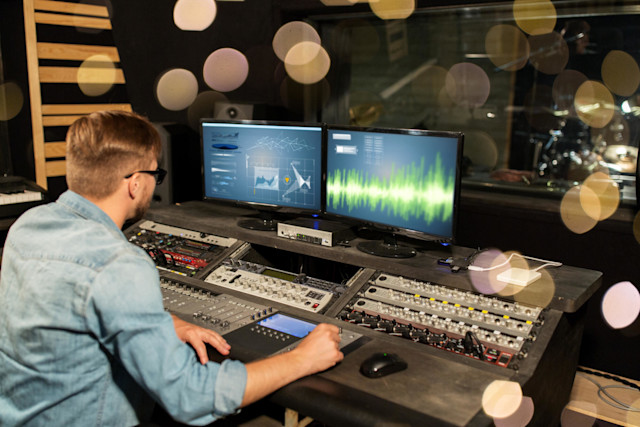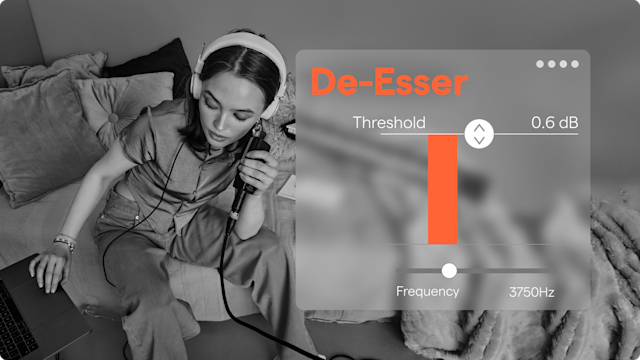What Is Audio Sibilance and How To Fix It With a De-Esser?
January 16, 2024 | Anton Berner

What Is Audio Sibilance and How To Fix It With a De-Esser?
Ever tried recording vocals for a song or voices for a podcast? You've likely encountered the pesky issue of sibilance. It's that harsh or excessive 'S' or 'SH' sound that becomes extra noticeable when recorded through a mic.
When sibilance runs wild, it's not just annoying-it can be downright distracting. It makes focusing on the words or vocal performance a real challenge. So, let's dive into what audio sibilance is and how to tame this irritating sound.
We'll cover ways to reduce sibilance and even how to use a de-esser to get rid of sibilance from an existing recording. No more hissing and spitting, we promise! For more info on Soundtrap's de-esser, visit this product page.
What Is Sibilance?
So, what's audio sibilance? It's the 'S' and 'SH' sounds in vocal recordings. They might not bug you in person, but capturing vocals through microphones can make them much more pronounced, resulting in piercing and harsh vocals. For instance, recording a podcast with a close-up condenser mic can make these sounds stand out.
Excessive sibilant sounds make the audio harsh and unpleasant. Combine that with a bad audio mix, and it's pretty painful to listen to. Why? Sibilant sounds occur in the 2kHz to 8kHz frequency range, where our hearing is most sensitive.
Sibilance is natural in speech, and we don't notice it in normal conversations or unamplified live performances. The issue only pops up when you record or amplify vocals with a mic.
How to Reduce Sibilance in Recordings-Microphone Selection
Sibilance can be a headache for audio recording newbies. It's often caused by bad mic technique or poor mic selection. In our digital age, producers love tweaking plug-in settings. But with mic recordings, you need to nail it in real-time.
Choose the wrong mic or place it poorly, for example, in a room with bad acoustics, and you'll get a subpar recording full of sibilance. The best way to cut it out? Pick the right mic and place it correctly. You also need technical know-how and a singer with proper technique.
Read more: Choosing the Right Microphone for Instrument Recording
Selecting the ideal mic isn't a walk in the park. You need one that doesn't just reduce sibilance but also suits your project. Generally, go for mics less sensitive to high-frequency sound. Avoid those that accentuate the 2kHz to 8kHz range for a sibilance-free recording.
Consider directional mics, like dynamic ones (e.g., the SM57). They help cut ambient sibilance that sensitive condenser mics may pick up. Of course, test different mics to find the perfect one for minimizing sibilance and matching your vocalist's needs.
A dynamic mic might work for heavy metal singers like Lemmy from Motorhead (who loved his SM57), but intimate performances from artists like Billie Eilish need more sensitive mics, like condensers. If you're working with a vocalist who needs a sensitive mic, take measures to lessen sibilance by placing and setting up the mic properly. For instance, with a sensitive condenser mic, sibilance can sneak in if the singer is too close to it. So, be sure to keep an appropriate distance between them.
Experiment to find the optimal distance. If the singer's too close, you'll get sibilant noise. Too far away, and they'll lose vocal power. Sometimes, angling the mic away from the sibilant noise helps but may reduce the quality of the recorded vocal performance. Consider using a pop filter to dampen sibilant frequencies.
Pop filters can work well, but be aware they can change the mic's characteristics. If you need a pop filter but don't have one, use a sock over the mic. Work closely with the vocalist to ensure proper mic recording technique. Inexperienced vocalists might sing too close to the mic or not through the pop filter.
Sibilance Test by Serious Gear
The Studio Space Matters Too
The room you record in impacts sibilance in the recording, so choose a room with proper acoustic treatment. Acoustically treated rooms absorb some sibilant tones, resulting in less noise. Ensure effective and accurate monitoring of playback of the sound of the microphone.
Read more: Soundproofing Tips for Music Producers: Make Your Home Studio Sound Better
Amateur recordings often lack sufficient monitoring setups, and sibilant tones become apparent in other settings. If unsure about your monitoring quality, use headphones to check sibilant levels. Remember to use studio-quality headphones, as commercial ones can color the sound undesirably.
A De-esser Can Help
So, you've recorded a band and got an amazing vocal performance, only to find out the track has too much sibilance. Going back to the studio isn't always an option. Maybe you don't have any more studio time booked; the vocalist is unavailable, or the performance is too good to toss.
You're not alone in this issue. To fix sibilance, audio engineers created a technique called de-essing. A de-esser is a specialized dynamic audio processor that reduces or eliminates sibilance. Nowadays, you can get a high-quality de-esser through audio plugins.
A de-esser isn't groundbreaking. It's like a compressor that selectively compresses sibilant frequencies when they exceed a certain threshold. You can adjust parameters like the threshold and compression intensity, and tune it to specific frequencies. When used right, a de-esser can reduce harsh tones while keeping the original recording's vibe and quality.
Check out the examples below, the rap vocals were recorded in Soundtrap with a condenser mic. The second audio sample has Soundtrap's De-Esser effect applied to it. See if you can tell a difference.
De-essing Vocals in Soundtrap
Every De-esser is unique, but they share common controls. Let's check out Soundtrap's De Esser.
First up is the frequency control, letting users fine-tune frequency settings to pinpoint sibilant tones. This means the Deesser works for various vocal performances, like adjusting for male or female vocals.
Next is the threshold control, affecting the reduction amount applied to the vocal. Lowering the threshold bar increases sibilance reduction in your selected frequency range. The cool thing about Soundtrap's De-esser? It has real-time monitoring. You can hear how much sibilance it's taking out of the vocal and experiment with mic placement while using the plugin.
Sometimes using a De-esser immediately during the recording stage can help if you've picked a high-frequency-sensitive mic and know you'll have some sibilance in the raw recording.
Lastly, the plugin has LED metering, showing when the Deesser is active and removing sound from the vocal.
Advanced De-essing
If your de-esser isn't cutting it, don't ditch the vocal recording just yet. Try advanced de-essing techniques for those tricky vocals. For instance, use automation in your digital audio workstation on specific de-esser parameters.
Maybe only a few words or phrases in the lyrics have bad sibilance, and the rest is decent. In that case, engage the de-esser for those parts only. You could also layer multiple de-essers with subtle settings. It often sounds more natural than cranking up the settings on just one device.
Don't Rely on De-essing Vocals Too Much
So, why not use a De-Esser from the get-go, so you don't stress about vocal technique or mic selection and placement? Hold on! The issue with De-Essers is that, while you can fine-tune them to affect specific syllable frequencies, they'll always remove other aspects of the vocal too. In some cases, this results in a less natural sound. Relying too much on De-Essing can make vocals flat, lifeless, and unnatural.
That's why it's crucial to nail a good vocal recording using just the mic and recording techniques. Don't use De-Essing as a crutch! You should only use it as one of your situational vocal mixing tools.
Ideally, a vocal recording won't need a De-Esser and will sound fantastic on its own. But let's face it: capturing a perfect vocal performance isn't always possible. That's where De-Essers come in handy-they're essential for rescuing otherwise useless recordings.
If you're using a De-Esser on every track, it's likely there's something off with your recording technique. Focus on tweaking that to reduce your reliance on De-Essers. But remember: a De-Esser is still an essential tool for music producers and recording engineers alike.
Take Care When You Mix Vocals
When dealing with sibilance, always remember it's about how it sounds in the mix. You might hear unpleasant sibilance when you solo the vocal mic, but less when the band plays along. Take a hard rock band with stacked Marshall amps, for instance. The layers of guitars might smooth out the harshness of the vocals and reduce sibilance in the vocal sound.
In this case, de-essing based on how the isolated recordings sound would be a mistake. To achieve a professional vocal mix, listen to the vocal with all other elements. Like any mixing, ensure a consistent sound across different speakers and headphones. Some might accentuate sibilance, leading to over-de-essing.
To avoid this, have multiple playback systems. It's also helpful to listen to the vocal mic on various sources while setting up. This helps identify problems before the vocalist starts up their performance.
You Need Soundtrap
Looking for a top-notch de-esser tool to polish your vocal recordings? Try Soundtrap's De-Esser. Soundtrap is a modern digital audio workstation that's all about collaboration. What makes it stand out? You can easily work with others, regardless of location or device.
Soundtrap also offers other various vocal mixing tools like Reverb, EQ, Delay, and Compression. Plus, it has a vast array of virtual instruments and royalty-free samples. Want to up your music production game? Give Soundtrap a shot.
Don't worry about breaking the bank - there's a free option to get a feel for the Soundtrap ecosystem. And if you're ready to commit, check out our pricing options for a subscription that suits you.
Om skribenten
Anton Berner är en musikproducent, ljudtekniker och låtskrivare från Stockholm, Sverige. Han har producerat hiphop- och rapmusik sedan början av 2000-talet och hans expertis är inom sångmixning och samplingsbaserad beatproduktion. Anton är även SEO & Content Manager @ Soundtrap och sköter bloggen och nyhetsrummet.
Kom igång med Soundtrap idag!
